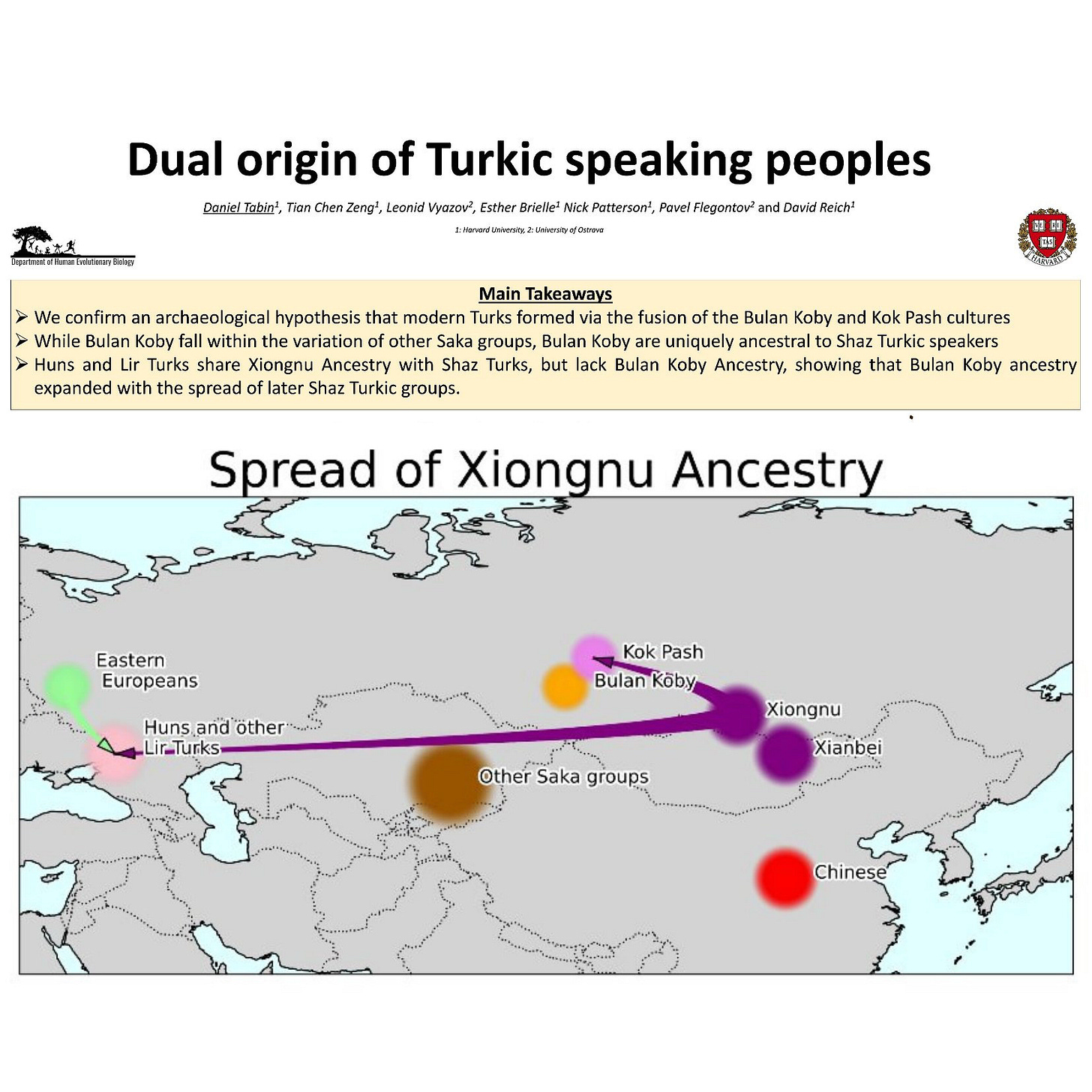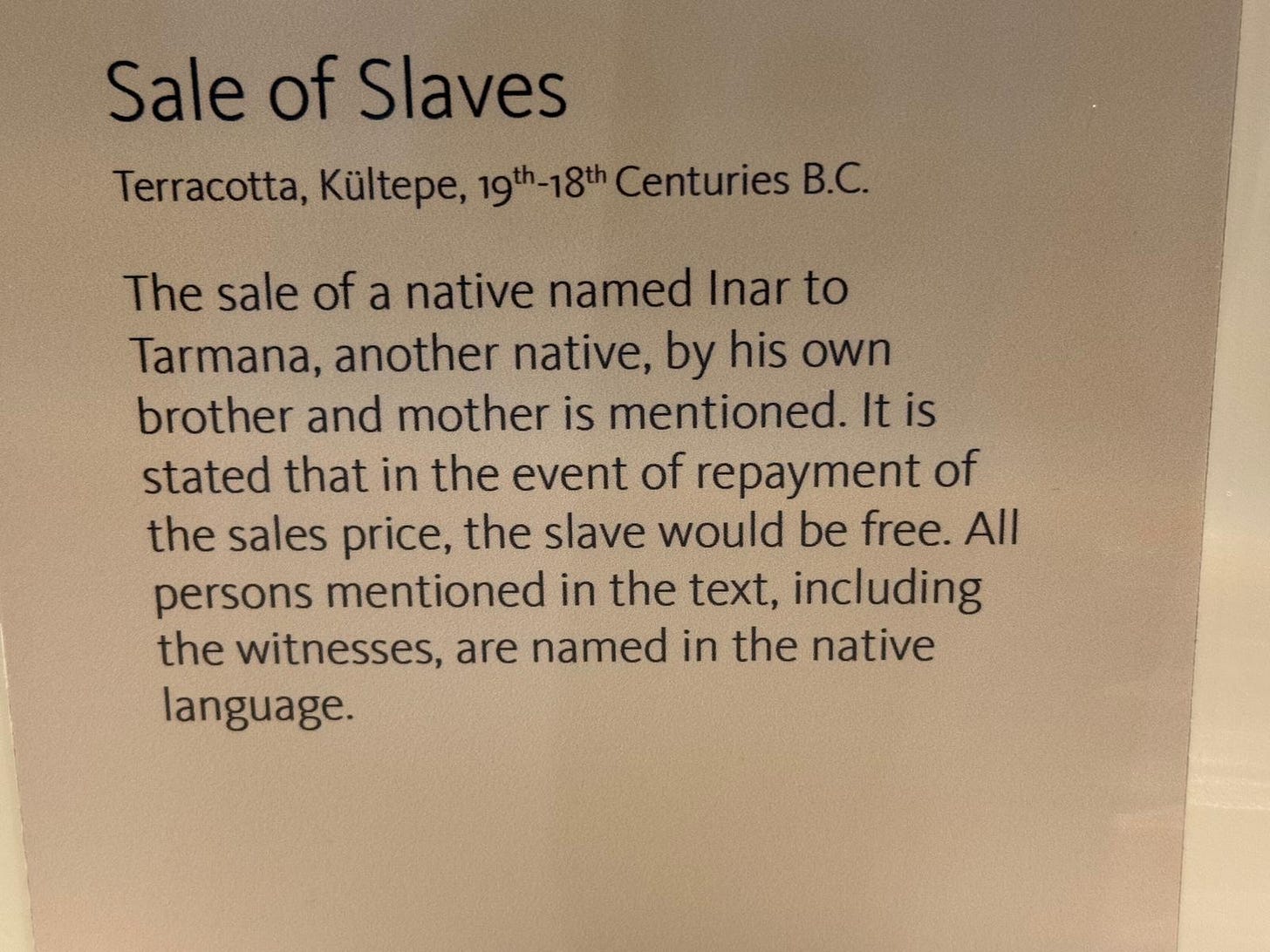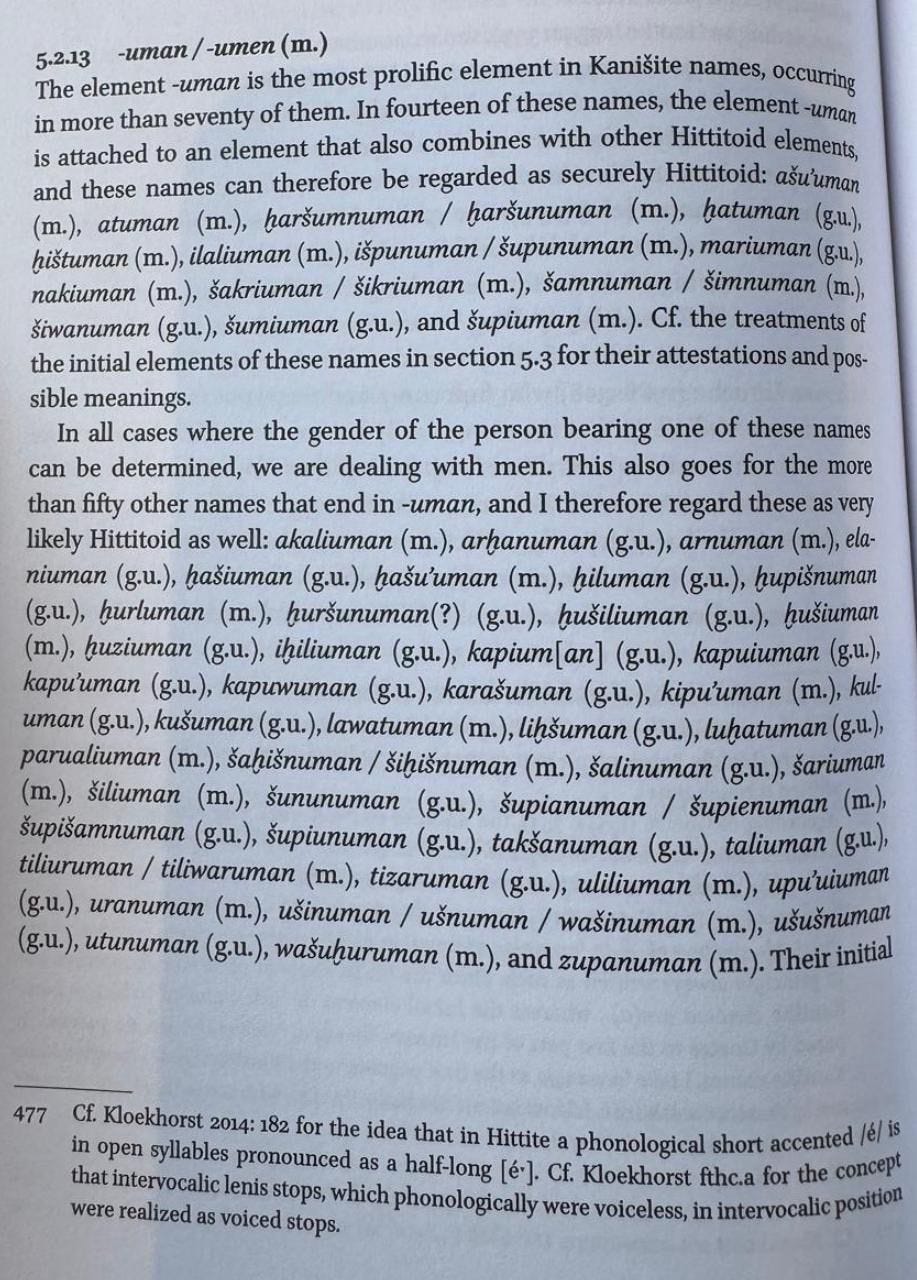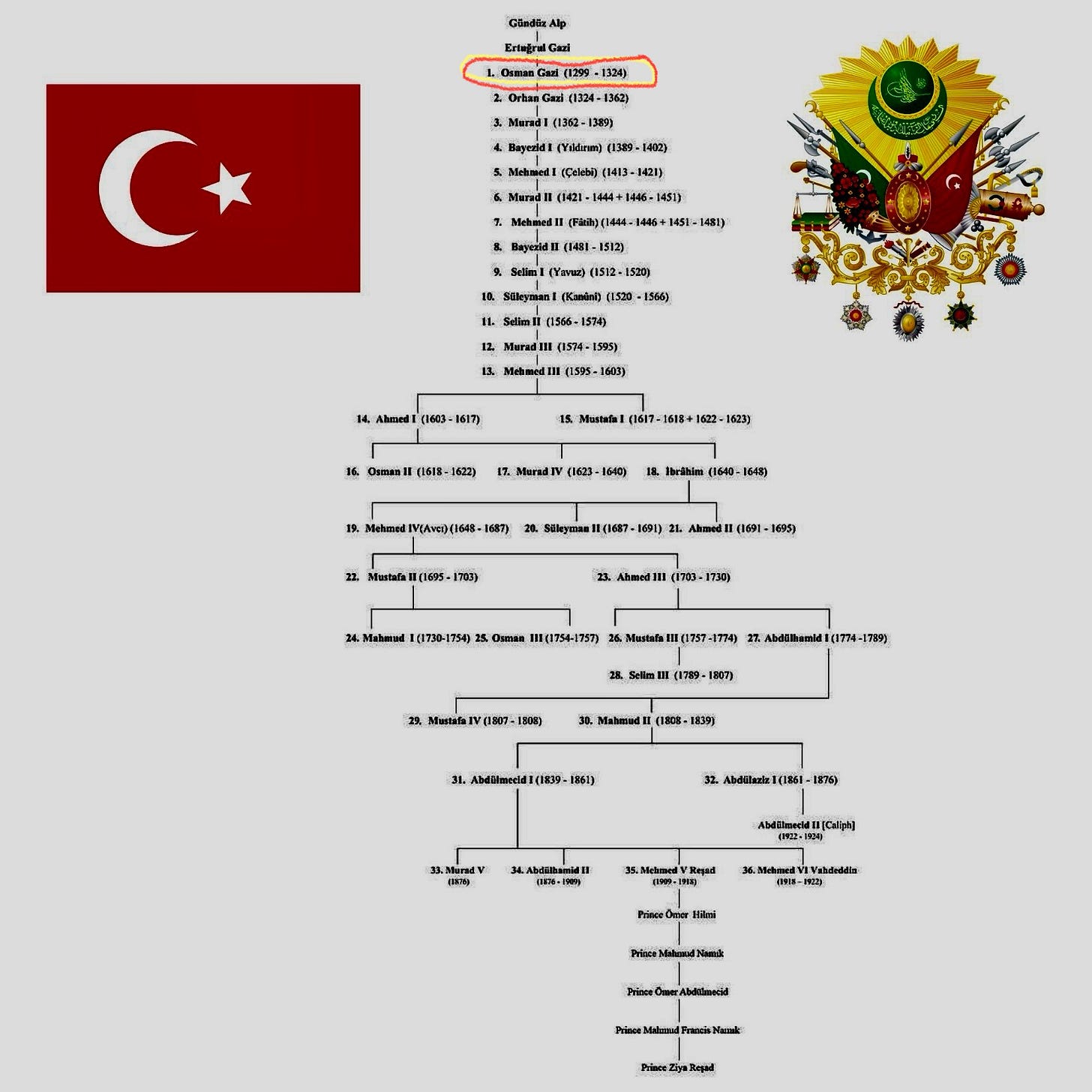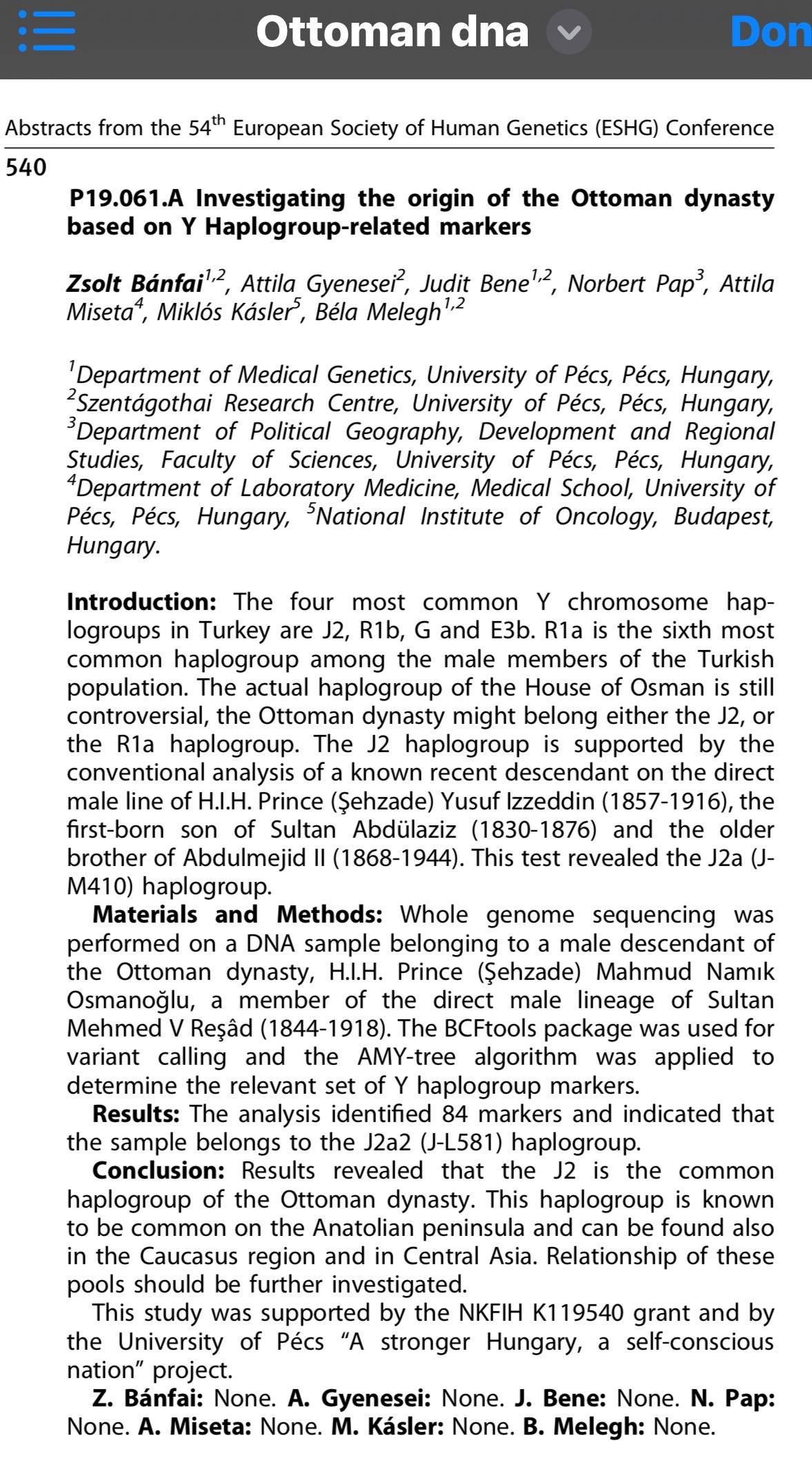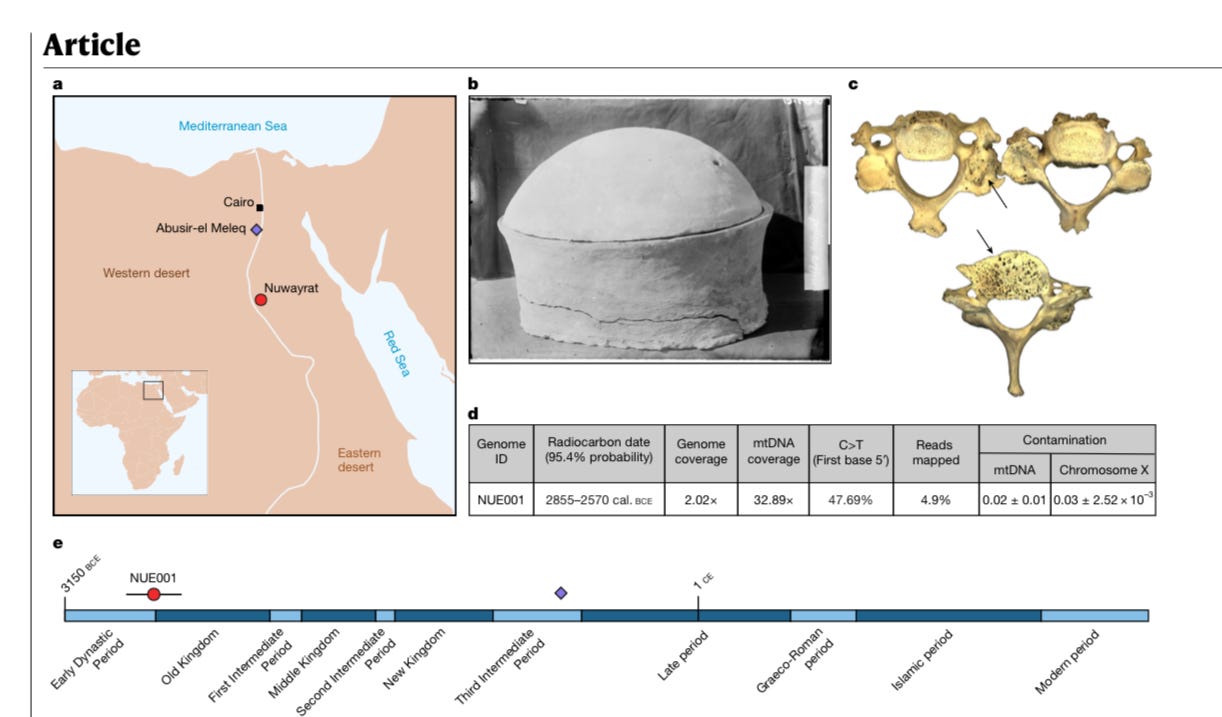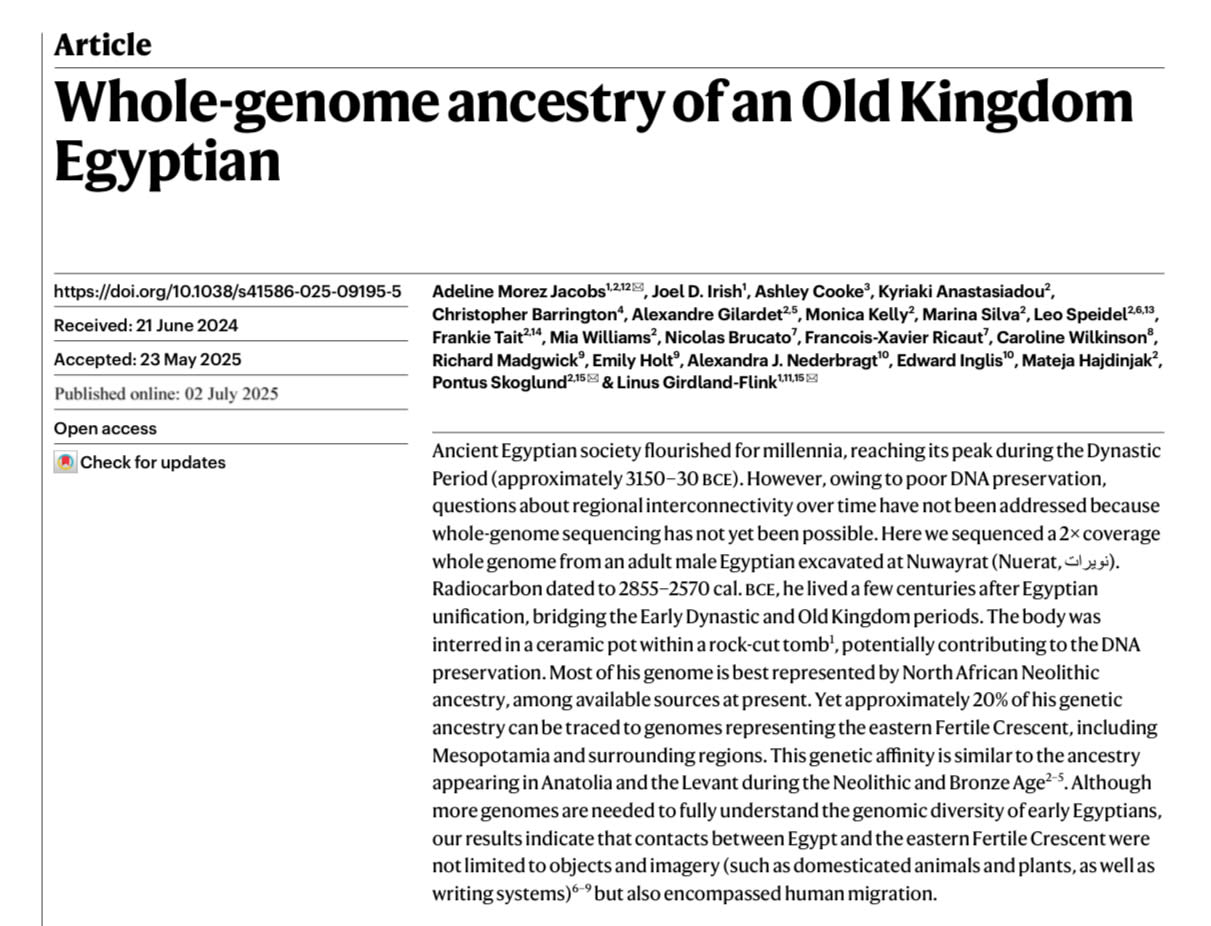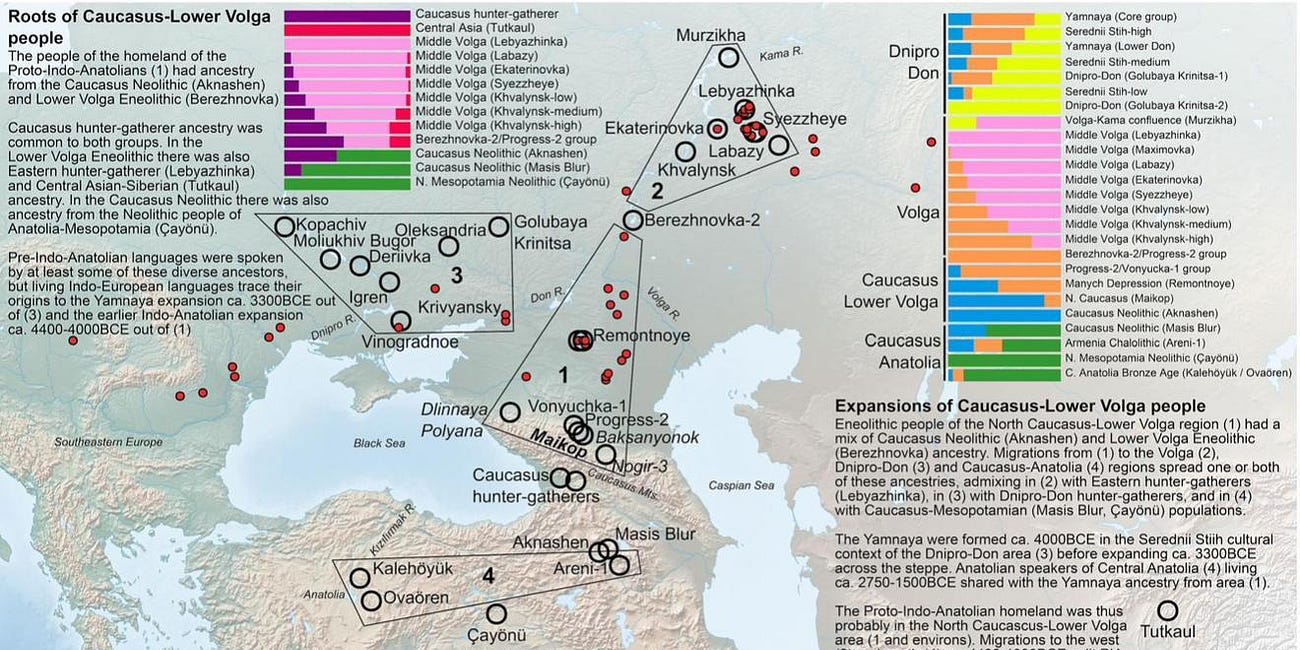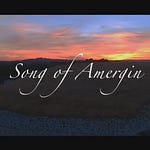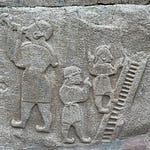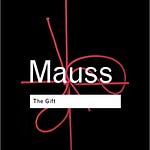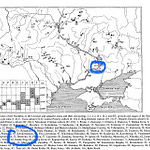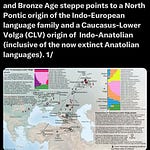M-N- sound appears to have many of the same meanings in Turkic as well as in Indo-European languages (Manas is the mythological founder of Turkic Kirghiz culture, Zaman signifies time in Turkish, for example).
M-N- might therefore be Turkic rather than of Indo-European origins?!
Especially where its meanings and immanences hover around the same Moon-based metaphorical semantic signalling system of southern Ukraine from ~4,100 BCE as Finding Manuland has so far been elucidating.
However, among the first documents with writing in any Indo-European language is this text I photographed in Ankara.
It mentions a native Anatolian language speaking (Indo-European as distinct from an Assyrian language speakers) Tarmana (1,900 - 1,800 BCE).
Also, since modern linguists determine the -Uman element was ubiquitous in the first attested Indo-European language - Kanisite Hittite (1,900 - 1,800 BCE), it’s clear M-N- was in Anatolia five millennia before the first Ottoman / Mongol Osman brought it there around 1,200 CE from Central Asia / Quaziqstan.
it seems clear M-N- transferred into Turkic as the first Central Asian Turkic language speakers with Ancient Ukrainian so-called Steppe / Scythian ancestry millennia later abandoned their Indo-European tongues.
Then with much later Turkic migrations into, say, Anatolia with Osman, the founder of the Ottoman / Osman dynasty that would dominate Anatolia from 1,200 CE onwards, M-N- returned and just become another source of M-N- immanent toponyms and words / meanings relating to measurement and the Moon-based metaphorical semantic signalling systems in formerly Indo-European occupied areas such as Anatolia.
So Finding Manukand’s immanent message of unity between apparent Indo-European peoples who are ignorant of our common origins now extends to Turkic language speaking peoples.
We’re united by our use in almost every sentence of signifiers emanating from the Moon-based semantic signalling system generated in Ancient Ukraine ~4,100 BCE onwards.
These sounds / meanings recognisable by the mnemonic M-N- have been injected as an immanence into every living Indo-European language, culture and religion from there, and now also, I demonstrate, into every living Turkic language too.
Let’s therefore use this as a further reason to dissolve political, personal and community conflicts grounded on linguistic differences!
We truly are All Ukrainian!
Hi there, I'm Decoding Trolls. This is Finding Manu Land. It's very hot where I am, so please forgive me. I'm deep in Manu Land. So I thought today we'd go through a little bit of a précis of where we are. The other day, somebody asked me about the MN sound and where I am with my research.
And over the course of about 40 minutes, I outlined the whole system to them, including some of the latest discoveries which was extremely exciting to me but which I haven't yet properly explored. So I'm going to hang these new little frames around various parts of Manuland, which is the area between Ireland and India. and in geographical and over time, it's between 4,100 BCE and today. And I'm gonna hang these little strands on like those little hooks that you put towels on in hotels or what have you. So each Finding Man Who Land episode goes goes through the Finding Manuland method, which is basically mana as energy exchange, the linguistic elements of the MN sound, as well as the voyaging, the journeying aspect, which is obviously the element which is the most exciting and perhaps the most accessible for those of us who aren't specialists in linguistics or energy exchange or Didn't know they were experts until they discovered Finding Manu Land.
So, of course, the journeying component, the third dimension of each Finding Manu Land episode and of the entire Finding Manu Land method, if you like, is journeying. So geographical between Ireland and India, that space which I call Manu Land.
And obviously now we have the Americas and Australia and various other places, but I'm talking about the traditional areas which became anchored in Indo-European languages after around 1100 years before the Common Era, BC. And there's also this temporal aspect, so 4100 BCE, when the Yamna in southeastern Ukraine spoke the first Indo-European language and began migrations. As we know, the first wave of migrants from there basically ended up colonizing the whole of Anatolia, which is today's Turkey, and establishing the first Indo-European empire, which was the Hittite Empire. And then the second wave was really around 2500 BCE. And out of that wave of migrations emanates all of today's living Indo-European language families. And in between those times and since those times, there's just constant successive wave after wave after wave, but let's call them subwaves.
Before the advent of ancient DNA, Maria Gimbutas, the brilliant Lithuanian-American scholar who discovered the steppe theory of migration, which is now as factual as we can get since the advent of ancient DNA, she was looking at different archaeological artifacts, which she was part of digs in all across Europe, and she was able to develop a timeline across Europe, which corresponded to three waves of steppe migrants. That has evolved a little bit since the advent of ancient DNA, but it's essentially what she discovered is still correct. And so when Jung was writing in the 1930s and the 1940s about archetypes, and hypothesizing that archetypes must be universal to all humans because otherwise how would you explain how Tibetan monks would have the same archetypes of the Lord of Death, for instance, as people in Ireland who had Lord Don, Lord of Death, there. apart from, as he put it, the wildest migration theories, which were going around.
Well, Maria Guimbutas, she established as a matter, as a question from linguistics, from archaeology, and also from mythological. She did a lot of work on folk songs and... from the Baltic countries and was able to establish continuities between Vedic, Indian folk songs and Irish and other Indo-European traditions. And so we have these different strands, these different vectors of evidence that we can look at and go, oh, wait, there's something connecting, there's some strands connecting all of us. Of course, as finding Manuland adherents or watchers know, We all understand now that William Jones, Sir William Jones, a Welsh Sanskrit scholar who was translating, who learnt Sanskrit, which is an ancient Indian language, not the most ancient, but one of the most ancient Indian languages called Sanskrit.
He was translating the Manusmriti, Manusmriti, so those two sounds which are very important to find in Manuland, MN, Manu. Smriti, mriti, the riti, the rite, the rite, the truth, the non-illusory. The man is smriti, which was the, I mean, you can almost translate now Sanskrit and the rite is in Sanskrit as well.
So it's this rite, rite, rite, rite. In monarch, it basically means truth, which then goes into Dwa, law. The law should represent the truth so that we see the semantic spread and nominal spread, the spread in the symbols. But the Manu Smriti, the laws of Manu is how it's usually translated.
And Manu was the first human in Indian culture. And they were written down around 600 words. years into the Common Era, so there are later extrapolations, whereas Manu, as the first human in Indic tradition, first appears in writing, as far as we're aware, around 1100 years before the Common Era, before Christ, in the Rig Veda, there's that Righ, it's sometimes represented as Righ, and so Rit, Rain, Regina, So anyway, we won't dwell anymore on the wreck sound. I'm back the next day. It was so hot yesterday, my iPhone kind of overheated. Looking forward to the iPhone 17, which has this air cooling inside. But anyway, so each episode of Finding Manly Land deals with the mana, the energy exchange element. The second is the linguistics element. And the third is the voyage, so the conceptual element. the geographical voyage, as well as the temporal voyage and the uprooting of the mental models.
So when I was describing to my friend where we're at with Finding Man in Land, I went through the whole universe and I thought, so I thought I'd record it and tell you where I'm at, where we're at. I've made quite a few amazing advances recently, which I have yet to explore properly.
I've mentioned a couple of them in recent videos. And as you'll probably notice, well, maybe you won't, but please do now. So when I put up a video or a podcast, I often... So we won't dwell any further on the rec sound for this. So every Finding Man in Land podcast, we go through the MANA exchange.
We go through the linguistics element of the MN sound. We go through the voyage, the journey. So the journey, the geographical journey, but also the temporal journey, the conceptual journey to alter our mental models and to populate the mnemonic, which MN represents in almost every sentence we speak or we hear in an Indo-European language.
because the point of it is in some ways the energy exchange element. And there's two dimensions to this which I've recently discovered. One from this discipline which is called social psychology or cultural psychology. And long before I knew that cultural psychology existed, I thought of myself or I began to label myself as a cultural archaeologist. And...
cultural psychology one of the uh emerging dimensions of it is really looking into consumer behavior and how fashion uh works and how contagion so that um the first time you see me wearing this thing on my head you think gosh that looks absolutely ridiculous but then you go outside and you see someone else wearing it and I guess even looking at this device here, which originates in Afghanistan and gradually spread across Central Asia to become quite popular in Thais, and now it's on my head. And so we have this phenomenon in human culture of how different cultural phenomenon, whether words, music, ideas, clothes, designs and basically anything that we can recognize or we can, cognition-wise, that is susceptible to this idea of contagion. And essentially, this aspect of social or cultural psychology emanates from one of the same sources that my work emanates from, which is this amazing writer, Marcel Mauss, who noticed that manna... the manor exchange in Polynesia was equivalent to Orenda elsewhere and it's this idea of how people exchange energy and they use this moniker manna in Polynesia. He was writing before we knew about how Polynesia was populated by migrants from various different parts of the world. And so the manna that they exchange, which is part of their religion, that is now seen in cultural psychology as a mechanism through which to examine and look at how various fashions take place and they use the term contagion and this idea of contagion is very much hardwired into the beginnings of my understanding of manna as a method to describe this essential exchange of energy between sentient beings, between humans and that N animals, this N and the anima animal, the N and the M reverse, as they do in Numitor, who is Romulus and Remus's grandfather, is the mani backwards. And so we have this slight reversal, which is a phenomenon in linguistics that Ferdinand de Saussure also noticed. And so the idea of some of you will have read and I'd encourage you to read it because it's probably my greatest piece, which is the meaning of meaning, which is me announcing that I found one of the cryptotypic signifying things. systems underlying all human communication in Indo-European languages and that is this MN sound that in there I'm talking about this this mnemonic through the sound through our language of a physical phenomenon which on the micro scale happens in our mitochondrial in the aspect of our mitochondrial cells the cells that each of us in each of our cells has two different genomes one of them mitochondrial dna and which is quite a small genome of maybe 32, 35 different genes. And this is essential.
This is the aspect of DNA which launched the ancient DNA revolution. So instead of having gazillions in the nucleic DNA of lines and lineages to try and trace. In mitochondrial DNA it's much shorter and It's the mitochondrial DNA. When I say that I've got step ancestry or Yamna DNA inside me, it's when we're looking at my mitochondrial DNA. And of course, the MN is in mitochondrial, but that may be a coincidence. I don't know. But anyway, mitochondrial DNA, so each cell, each element of it, it's powered. And the mitochondrial DNA is what gives our cells... their energy. And this, the ATP is the, I always remember this because it's a supermarket in Ukraine, which is owned by Yulia Timoshenko, who was the first female prime minister of Ukraine. Now we've got another female prime minister of the UK. It's her family's company. But the ATP, as they would say in Ukraine, the ATP is what powers our cells. And these energy generators are
And recently I had the pleasure of seeing these photographs of how particular organelles, they're called these mitochondrial cells, are joined with each other and connect with each other. So that's on the micro. But on the macro, it's me communicating with you. And the MN is in communicate as well.
So our Mana is exchanging, even though at the moment it's going one direction. But if you comment or if I just sense you're watching this or you continue to subscribe, then our manner is being not just going one way. It's being exchanged. And so we go from the micro inside our bodies to the macro, which is in whole human communities and the communal community. sense we are exchanging energy so the cultural psychology element is brilliant because when I discovered Marcel Mauss's work on the Polynesian this religion of manna I was obviously very interested because I was already interested in that man and now I think I can genetically connect it through the migrations the migrants and from South Asia, from India, and they could well have brought with them this signifier, manna, for the phenomenon of energy exchange, which all humans experience and which all sentient beings experience.
which part of the purpose of Finding Manuland is to try and remind ourselves in our communities when we've gotten so far removed from these basics of what it means to communicate with people every day, to smile at them, and we're exchanging energy.
And part of my purpose is to implant in our minds a reminder, a manner reminder system, through this MN sound that if you're scanning for the MN sound in meaning in all of these common words, which we use in almost every sentence, if when you're scanning for them, you spot it, it will remind you that in this interaction, We're exchanging manner and that's all that matters really. That is the essence of being human. It's the essence of living inside a community and keeping language alive. And MN, this MN sound at its most basic. meaning for me is to remind us of this energy exchange.
And so it's particularly interesting to discover this whole area of psychology, cultural psychology, which has taken Marcel Mauss's and Claude Levi-Strauss's insights from early 20th century cultural psychology on one hand or on the other side, from anthropology on the other side, and moved it forward into a very heavily resourced aspect of academia, which is to understand consumer behaviour and how fashions take hold and to discover that this series of researchers have explored elements of what I look at as part of the essence of being human, but they see it as an essence of human community and that they can use it to help sell things or understand how markets work and how human culture works was a great discovery for me. So I'll pause there and go to next. And so the second element, which I've recently discovered, apart from the cultural psychology bit, which we will explore a lot in time to come. So I'm just giving you the outlines of where we're at and where we're going with Finding Manuland. is the essential in Tibetan Buddhism, which is an Indo-European religion, we have this idea of bodhicitta, which is what distinguishes Tibetan Buddhism from, for instance, Sri Lankan Buddhism, or as the Dalai Lama would call it, Sanskrit tradition from the Pali tradition. And the Sanskrit tradition, there's this essential idea of bodhicitta, which is that everything one does as a Buddhist is for the sake of all sentient beings. And the idea is how do I generate this bodhicitta, which is more than compassion. It's an entire motivation for our practice, but for everything we do. And it is the core element in Tibetan Buddhism and the Sanskrit tradition. And there's two parts to that. One is, or there's two ways of generating this motivation, Bodhicitta, which is supposed to underpin one's entire existence and one's entire practice. One is remembering the love that one's mother, if one is lucky enough to have known one's mother and to have known her through life. But if one isn't, one can remember seeing other depictions of this, or perhaps friends, good friends, the love a mother has for their child, as James Joyce puts it in Ulysses, Amour Matris. which is the love of the mother. And it's the core way, one of the two core ways of motivating what is called bodhicitta, which is the spirit of enlightenment or the awakening spirit, which is basically for the benefit of all sentient beings. Everything that you do is for the benefit of all sentient beings. As distinct from the Sri Lankan, or a Thai tradition where you seek enlightenment for yourself.
And if we have a community of enlightened humans who have worked very hard on their minds, then you will have a positive community. In Tibetan Buddhism, one seeks enlightenment for the benefit of all sentient beings, not just for oneself. So it's trying to get to the same result, but through different means through a different method, all emanating from the Buddha. And the second core way of generating this is exchange of self and other. And so if we look at the cellular level, each of our cells and the mitochondrial cells are we can actually visually see and I'll put when I print this, when I post this and it auto generates the transcript and then gradually I correct them. I try to do this with all of these videos and all of the podcasts and indeed with all of the written text and finding manual and all the episodes as we move forward.
I think we're on episode 45 or something now, maybe even more. I can't remember. So I am gradually, I'm quite slow, but I'm gradually working through them all. And so I put the references in and screenshots and I will of these mitochondrial cells, these cells communicating with each other. So they are exchanging self with other.
And if you remember this element of exchanging self and other, this manner exchange, then that is really the core, the fundamental aspect of human community in Tibetan Buddhism and the worldview. And you don't have to be a Buddhist to recognize how you can be energized in a positive way or a negative way by other people coming into your awareness or consciousness, whether over the internet and trolls and motion-moving activity of body, speech and mind, or in your own life that you're feeling a bit down and someone you love comes in or your kitten comes in and starts looking for love.
So that is the manna element, the manna exchange element. So we'll be looking a bit more at that and tracing that. One of the first podcasts I did was on the X energy. And so this is the idea of manna This is also the idea powering Tibetan Buddhism, but it's also on the micro level, the idea which is powering our mitochondrial DNA. So the second dimension to every Finding Manuland podcast is the linguistic element. And the linguistic element is... Obviously, so someone said to me recently, the MN sound, I wonder, can we get to, is this just a fundamental sound that humans make, like biologically, and perhaps certain types of humans?
And perhaps it is. It probably is. MN.
No.
I don't know. But what is particularly Indo-European about the MN sound is that in many cases, we can trace it to... community in southeastern Ukraine's use of the MN sound in menyot, meaning moon, meaning the mechanism for measuring months and days and moments is the meaning of And the idea of meaning, if my hypothesis is correct, my plausible hypothesis is correct, is that the light shining through the moon, so the alluminate light shining through the moon, is the moon-based metaphor that underpins much of our language in Indo-European languages, In humans, the idea of the mind shining through the human, through organic character, which is the difference between the human and the stone, and the sentient beings, and animating us. And so this light shining through the moon, being the moon-based metaphor, then coming through in the word, in the signifier, meaning, which is the idea of one being, particular signifier shining through another particular signifier and their meanings being connected the metaphor the idea that you're bringing a meaning across from one part to another and of of these networked connections is the totality of the language that we use and the meanings that we communicate and of this particularly effective means that humans have evolved and animals have evolved of exchanging manner so it's not just a an organic or biological medium or means of keeping each other alive. It's not automated as hopefully our mitochondria will the energy exchange from one cell, one mitochondrial cell, the ATP in each of my cells, the little energy factory, and that communicating energy to other cells. And we have evidence of how when particular cells, the ATP, the factory, isn't working very well, creating energy to keep that cell alive, others will communicate energy easily. And we can see these now with these incredible, I don't know what you call them, unbelievable microscopes that you can see the actual connections between our cells, between the ATP, between the mitochondrial elements of the cells.
But that's also on the linguistic element that I can communicate many more complex thoughts to you through the language and the meanings. And the language and meanings which I'm using in Indo-European language to you now are made up of these networked connections, all generated from these fundamental metaphors, the most fundamental of which in Indo-European languages, as far as I can see, is this MN. sound. And so we see this MN sound in across the Indo-European linguistic sphere. But there are also mysteries, which I've pointed out before. For instance, in Turkey, we have MN everywhere. It's everywhere in place names, just as in Ireland, we've got MN in everywhere.
And so we can explain the MN everywhere in Ireland by there's this direct genetic link with the Manapi who came in from Cassels, which you might remember from my second episode, the first and second episodes of Finding Manuland. I've yet to put it into podcast form, but it's there in the text. And Cassels, which was the centre of this great empire, which gave its name to the Mosh, which is the French name for the French Channel, or the English Channel, and many Mons men, where Finding Manuland began life. And many places, Monaghan, Fermanagh, Kilmanton, which is Wicklow, the Irish for Wicklow, or Loch Gorman.
So this MN sound is in thousands of place names in Ireland, but also... in Turkey. And of course, we have the Ottoman Empire, which began life with Osman. And in Turkic language, Osman was the founder of it. And in the past few weeks in Nature, the preeminent scientific journal, Humanities' preeminent scientific journal, has published the analysis of one of the successors in the Ottoman Empire, who's still alive today, and to trace their DNA back to Osman and the particular geographical location in Central Asia, in Kazakhstan. And so the people who migrated from there, who would eventually take over Anatolia from us Indo-Europeans. So we had successive waves who occupied Anatolia from the first great empire that really unified Anatolia, the Hittites, which I talk about a lot. And we now have, can trace the Ireni one man, who Ireni is in a country called Armenia, and in Armenia, of course, and the Ireni one man from about 4,000 BCE is Their DNA then reappears in the Hittites 2,000 years later. So we've got this genetic trace. We've got the linguistic trace. The Hittites used Zeus for God and Zeus, Jupiter, and in the Hittites. And so we can deduce probably already one man. was an Indo-European and brought with them and the other migrants that went with them to find the Hittites 2,000 years later to become the first great Indo-European empire in Anatolia and in today's Turkey. Then you have multiple other Indo-European waves. You have the Greeks, you have the Lycians, the Silicians, the Armenians, who are actually from where their base was. They were the great around 50 years before the Common Era.
Armenia was at its greatest extent. And there was three different states across Anatolia. So you just have these successive waves. But the end of Indo-European dominance... in Anatolia, in Turkey, began with the migration of what are often called the Mongols, but in fact are the Turkic language speaking people. And we can trace from the Ottomans, the sublime ports, the Ottoman Empire, the Ottoman family, the Osman family who are still alive, and we can trace to their ancient DNA from where they emanate. So we know obviously they speak a Turkic language because the The clue is in the name, Turkey.
And we know the Turkic's emanated from this part of Central Asia and up near Mongolia. But it had been an issue for me, well, an interesting problem. uh to explore along with a million others about the mn sound obviously in ottoman and in osman the founder of this empire so we're talking about um i guess osman was around 1100 1200 bc i've got all the things which i'll i'll put in there i'm just giving you a brief survey of where we're at on the linguistic element the second dimension of each finding man who land podcast and and for further exploration, but where my thinking is at now, given this recent ancient DNA analysis.
And also the work which I've cited before about how we know that Uman was not just a sound and a meaning among the Hittites from these texts from 1900 to 1800 years before the Common Era. And always remember the third dimension of every Fine Uman and Uman podcast of this journey, the temporal journey between 6,000 BCE, sorry, 4,100 BCE and today, 2025. But there's also the geographical journey. So even in this short conversation, I've gone from Ireland to, we haven't mentioned India, to Turkey, we've gone to Armenia, gone up to Central Asia, to Kazakhstan. So we're moving our mind along. And I recognize you don't yet probably have all these anchors, but I'm dropping them into your mind so that... As we move on and move forward into these episodes, you'll have this kind of fluency which I've evolved, this plasticity through time and through space. But anyway, back to Osman. We know that umen sound is very important to the Hittites. It's just so important that modern linguists, if they're trying to distinguish between Assyrian and Hittite in texts, so these 23,000 texts on Kultepe Kanesh were the first example of Indo-European writing was found and which I visited in Ankira, the Celtic language-speaking people founded Citi, which is today's capital of Turquia. And that was founded, and Ciro was founded by Celtic language-speaking people about 300 years before the Common Era, before the Romans conquered them. So again, this theme of successive waves of Indo-European language-speaking peoples conquering and moving into Anatolia and Turquia. And then this break, which is often represented as the fall of Constantinople, as this terrible moment in traditional historiography.
But that began, the fall of Constantinople began with Osmond. the founder of the Ottoman or the Osman dynasty, arriving in Anatolia with the Mongol invaders and starting off with all of these battles, which we'll probably in future episodes, we'll go to and we'll trace their routes across Anatolia. We'll go to the places and try and...
We've already been to one of the places of great fights, which was in Sakarya, near the river, the Sakarya River in Gordian. I was there, we were there, we've seen some of the photos from there in January in a very foggy day where I found the first burial mound in the whole of Anatolia from not actually the Midas Mound but Mound W, close to the Midas Mound. And right close to there, the Battle of Saqqiria was one of the great fights against the Greeks, the modern Turks had against the Greeks.
So we have the Turkish language speaking Turkey against the Indo-European Greeks. And that kind of being the end of the Greek presence for now, who knows, in Anatolia. But so we have these successive waves over the millennia. whose remnants are in our stories.
And through all of them, from at least the time of the Hittites, is this MN sound. So we know if you're trying to distinguish between Assyrian and Hittite, between the Indo-European and the Semitic language, the Syrian in the texts, modern linguists use this Uman.
And when they see Uman, there they know it's Hittite, it's Indo-European, it's not Assyrian. And so we know the MN sound was present in Anatolia. We have textual evidence of its presence in Anatolia from 1900, between 1900 and 1800 BCE, so 4,025 years ago. Anyway, you can do the maths quicker than I can. 3,925 years ago.
And then from 1900 to 1800 BCE, so then we flash forward 3,000 years, three millennia, to the arrival on his horse with his cutlass of Osman, who's travelled with his crew all the way from Kazakhstan, from Central Asia, with his Turkic language-speaking people. And they arrive and bring this MN sound again.
But they're arriving in Anatolia to a place where the MN sound is embedded in so many different place names already. And we know this from Homer, from many of the characters in Homer, who's writing, who's from Anatolia, probably from Smyrna, MN sound, and around Hali-Karnassus, and that whole area, that coastal area.
And so MN is all over the early Greek stuff as well, and it hasn't just come from what we today consider Greece. What we today consider Greece is a function of the fact that the Persians, the Achmeniad, again, MN, so coming from the Persians, and we've looked briefly at other sources that one of the distinguishing words is used, the MN sound is all over there, Ariyam, and And so modern Turks will often describe words which are clearly Indo-European as from the Persian influence. They'll try and ignore the Armenian, and then in Armenia as well. So we've got these layers and layers of place names, which we know have been place names in Anatolia since at least 1900 BCE, from these texts in Coltepe, these 23,000 cuneiform texts which were found in in merchants' houses, Assyrian merchants' houses in Kultepe and Kanesh. And you remember, I visited there this time last year.
It was also very hot and I was wearing one of these things on my head. And we used the umen sound to distinguish the names of people. Tormana, you'll remember, we saw one of the earliest examples of Indo-European writing in the museum in Ankira. in january where it's described as a native anatolian and they don't tell you in the museum itself the museum is amazing by the way but they don't tell you in the museum itself that this cuneiform text which i photographed and i'll print on this and the transcript of this is one of the first writings in in the indo-european language anywhere. And Tarmana, again, MN in it is his name. But these texts also mention lots of places with the MN sound in them. So you flash forward 3000 years, and you get the Ottoman Empire is beginning when Osman comes in from Central Asia. So you're wondering, okay, wait, this MN sound is also embedded in the Turkic language speaking people. So we'll move on to this in a second. Hold So this is just a brief survey of where we're at.
So there's a moment in Neolithic times when the Mongol and the Scythian, so the ancient Ukrainian and the Mongolians who create the Turkic language around Baikal, meet. And it will be my hypothesis that the MN sound is also very ubiquitous in Turkic language. but that is a remnant of the Indo-European. And I'm not just being biased here, but we know that Uman is deeply embedded in Indo-European before its encounter with the Turkic language speakers, before its encounter with the Osman, who became the Ottoman Empire, this mighty empire, which unified Anatolia again and conquered it with the Turkic language speakers. But we know it's also present in Anatolia in almost every layer that comes in from at least the time of the Hittites of 2000 BCE, is their mythological foundation in this place, Kanesh, Kultepe. And then the height of the Hittite empire is around 1400 BCE. We know Areni, one man from Areni in Armenia, His ancient, his DNA is in the DNA that we find in Bogashkoy, which is the capital of the Hittite Empire. So we've got, and we've also got certain motifs, this amazing silver goblet, which was found in Armenia, the Karashamba goblet has the same motifs, as items which were found in bogus koi and in kanesh, sorry, and particular motifs which have not appeared anywhere else.
So we have this genetic ancient DNA connection. We have the artistic, the cultural, archaeological connection. And we also now have the linguistic connection. And that connection is manifest in the MN sound. And... This is a particular aspect of where we can follow the trail across from modern Turkey through Armenia up to Kazakhstan and all the way up to Mongolia, which of course is the MN Sound as well, deep in it. And the Mani culture in Mongolia is which is an archaeological culture, which is also another strand we want to explore. So this is how the linguistic combines with the...
the cultural and the migratory strands across Manuland from Ireland to India, from Lake Baikal up near Mongolia, near Inner Mongolia, down to where we were last January in Mount Hazis, which was where the gods lived, where the Hittite gods lived, and the Assyrian gods all lived. If you remember, drove up that mountain as far as we could get to the checkpoint of the turkey turkish army who were very polite but told us we could not pass which is fine made that nice podcast and so that's where we're at on the linguistic element and now we'll come back to the third dimension which will be the further strands for research and for talking uh in a second so the third aspect to every finding man who land episode is the The voyage element, the journey element, the geographical element, and the temporal journey between 4000 BCE and 2025. And also the conceptual journey, the mental models are mental models of a world in which Christ's self-sacrifice on the cross in the early Roman Empire is where Greek is the lingua franca and the structural tale which recurs in Odin and Germanic culture, in Celtic culture is the beginning of time. And in finding Maniland, what I'm trying to do is, as my brain has expanded, expand your temporal brain. your mind, your mental models as well. And so I've already done that. So I'm describing that's the third dimension of each Find a Man Who Learn podcast, but in looking at the manner exchange, but also with the linguistic element, the MN, and my latest adjoining of the ancient DNA studies with the the Osman and coming into the Turkic brings me to just to the end of this very brief in a I put it I think in a couple episodes here which is the meaning of finding man what is the meaning of all this so we've got the meaning of the MN sand as a mnemonic which reminds us about energy exchange which reminds us in the moment when perhaps we're getting a bit emotional, that we remember that actually the point of this interaction, whether we're in a shop or with a friend or with our enemy in the office, that the point of all of this is energy exchange. And that's all that matters really. And that's what life is about. So that's on the micro. On the macro, finding Manuland itself as a moniker for a space, a geographical space between Ireland and India, as a moniker for a temporal community, a unified community between 4,100 BCE and southeastern India. Ukraine, around her son, around where the Russians are today killing Ukrainian one-year-old child through first-person view drones. We're looking at the Yamna community spreading out from there and taking over linguistically the space between Ireland and India is an amazing story in itself. But now we can encompass the Turkic and we can look at the Mongolian Scythian unification, which say in Kazakhstan, we have this amazing unity of a community between the Iranian, the Indo-European Iranians, who were the Yamna who went.
all the way to the Sintashta and probably all the way to Iran. I haven't quite, we'll get to that, whether they then came back in the Neolithic, so still the Stone Age. And then they join with the Mongolian. And we have this, the Turkic and the Indo-European languages, just, and I'm not talking here about the Russian colonisers.
This is a really, very ancient Kazakhstan as a space and as a community. It has these two elements which go, we now know, through looking at ancient DNA, looking at the mitochondrial DNA of ancient humans in the Syntashti culture and elsewhere in Kazakhstan. This Iranian, the Indo-European and the Turkic, this is where they unified.
It's the space from which Osman came, as well as whole waves of migrants for millennia, including up to today, to conquer Anatolia, to take over Anatolia and to add their lair to Anatolia as many of our, and who knows what's going to happen in the future. So just as finding Manuland is essentially, it's not a message of division, it's a message of unity that Irish people, Indo-Europeans and Indian in Europe were the same. Pashtuns and Ukrainians are the same. We are from the same community. We speak the same language from the same language family. However, different the signs come. Our mythological founders often have these MN signs in their names.
And now we can do the same with the Turkic language speakers. this emanation from Kazakhstan, from this area where we can trace the connection between the ancient DNA of Osman and his living successors, his living descendants. And so that where we come across differences in human communities, which are founded or premised on linguistic differences between, for instance, the Indo-European language speakers and the Turkic language speakers, then Finding Manuland has a powerful new story to tell, which we can use to try and bind us closer together. And let me leave it at that for now. And we've got several years worth of podcasts and publications to make and a lot of travels to come.
And I'm very glad you're on this journey with me.
Much more on this over the coming years in future episodes, as well as on the meaning of the recent analysis of some of the first Ancient Genomes from early Egypt for Finding Manuland’s quest to understand M-N-‘s ubiquity in its sacred vocabulary (Amon) and names (Tutankhamen).
Continued from:
First in series:
Finding Manuland I
In October 2021 I was returning from my final vacation before my forced retirement from my beloved diplomatic posting to Ukraine.


